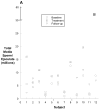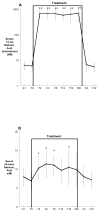Isotretinoin administration improves sperm production in men with infertility from oligoasthenozoospermia: a pilot study
- PMID: 28980413
- PMCID: PMC5678973
- DOI: 10.1111/andr.12420
Isotretinoin administration improves sperm production in men with infertility from oligoasthenozoospermia: a pilot study
Abstract
There is currently no effective medical therapy for men with infertility due to oligoasthenozoospermia. As men with abnormal sperm production have lower concentrations of 13-cis-retinoic acid in their testes, we hypothesized that men with infertility from oligoasthenozoospermia might have improved sperm counts when treated with isotretinoin (13-cis-retinoic acid). We conducted a single-site, single-arm, pilot study to determine the effect of therapy with isotretinoin on sperm indices in 19 infertile men with oligoasthenozoospermia. Subjects were men between 21 and 60 years of age with infertility for longer than 12 months associated with sperm concentrations below 15 million sperm/mL. All men received isotretinoin 20 mg by mouth twice daily for 20 weeks. Subjects had semen analyses, physical examinations, and laboratory tests every 4 weeks during treatment. Nineteen men enrolled in the study. Median (25th, 75th) sperm concentration increased from 2.5 (0.1, 5.9) million/mL at baseline to 3.8 (2.1, 13.0) million/mL at the end of treatment (p = 0.006). No significant changes in sperm motility were observed. There was a trend toward improved sperm morphology (p = 0.056). Six pregnancies (three spontaneous and three from intracytoplasmic sperm injection) and five births occurred during the study. Four of the births, including all three of the spontaneous pregnancies, were observed in men with improvements in sperm counts with isotretinoin therapy. Treatment was well tolerated. Isotretinoin therapy improves sperm production in some men with oligoasthenozoospermia. Additional studies of isotretinoin in men with infertility from oligoasthenozoospermia are warranted.
Keywords: 13-cis-retinoic acid; male infertility; semen analysis; spermatogenesis; spermatogonial differentiation.
© 2017 American Society of Andrology and European Academy of Andrology.
Figures






Similar articles
-
Intratesticular 13-cis retinoic acid is lower in men with abnormal semen analyses: a pilot study.Andrology. 2013 Mar;1(2):325-31. doi: 10.1111/j.2047-2927.2012.00033.x. Epub 2012 Nov 29. Andrology. 2013. PMID: 23413144 Free PMC article.
-
Effects of high doses of recombinant human follicle-stimulating hormone in the treatment of male factor infertility: results of a pilot study.Fertil Steril. 2006 Sep;86(3):728-31. doi: 10.1016/j.fertnstert.2006.02.087. Epub 2006 Jun 16. Fertil Steril. 2006. PMID: 16782097 Clinical Trial.
-
Double-blind, randomised, placebo-controlled trial on the effect of L-carnitine and L-acetylcarnitine on sperm parameters in men with idiopathic oligoasthenozoospermia.Andrologia. 2019 Jul;51(6):e13267. doi: 10.1111/and.13267. Epub 2019 Mar 15. Andrologia. 2019. PMID: 30873633 Free PMC article. Clinical Trial.
-
Chromosome abnormalities in sperm from infertile men with normal somatic karyotypes: oligozoospermia.Cytogenet Genome Res. 2005;111(3-4):347-51. doi: 10.1159/000086909. Cytogenet Genome Res. 2005. PMID: 16192714 Review.
-
Carnitines and male infertility.Reprod Biomed Online. 2004 Apr;8(4):376-84. doi: 10.1016/s1472-6483(10)60920-0. Reprod Biomed Online. 2004. PMID: 15149558 Review.
Cited by
-
Biochemical and physiological importance of the CYP26 retinoic acid hydroxylases.Pharmacol Ther. 2019 Dec;204:107400. doi: 10.1016/j.pharmthera.2019.107400. Epub 2019 Aug 13. Pharmacol Ther. 2019. PMID: 31419517 Free PMC article. Review.
-
Retinoic acid can improve autophagy through depression of the PI3K-Akt-mTOR signaling pathway via RARα to restore spermatogenesis in cryptorchid infertile rats.Genes Dis. 2021 Apr 2;9(5):1368-1377. doi: 10.1016/j.gendis.2021.03.006. eCollection 2022 Sep. Genes Dis. 2021. PMID: 35873030 Free PMC article.
-
An Integrated Analysis of Network Pharmacology, Molecular Docking, and Experiment Validation to Explore the New Candidate Active Component and Mechanism of Cuscutae Semen-Mori Fructus Coupled-Herbs in Treating Oligoasthenozoospermia.Drug Des Devel Ther. 2021 May 17;15:2059-2089. doi: 10.2147/DDDT.S307015. eCollection 2021. Drug Des Devel Ther. 2021. PMID: 34040346 Free PMC article.
-
Differential responsiveness of spermatogonia to retinoic acid dictates precocious differentiation but not meiotic entry during steady-state spermatogenesis†.Biol Reprod. 2023 May 10;108(5):822-836. doi: 10.1093/biolre/ioad010. Biol Reprod. 2023. PMID: 36708226 Free PMC article.
-
Development and Validation of the Isotretinoin Hesitancy Scale for Acne Vulgaris: A Preliminary Study.J Cosmet Dermatol. 2024 Dec;23(12):4094-4101. doi: 10.1111/jocd.16589. Epub 2024 Sep 18. J Cosmet Dermatol. 2024. PMID: 39291853 Free PMC article.
References
Publication types
MeSH terms
Substances
Grants and funding
LinkOut - more resources
Full Text Sources
Other Literature Sources
Research Materials

